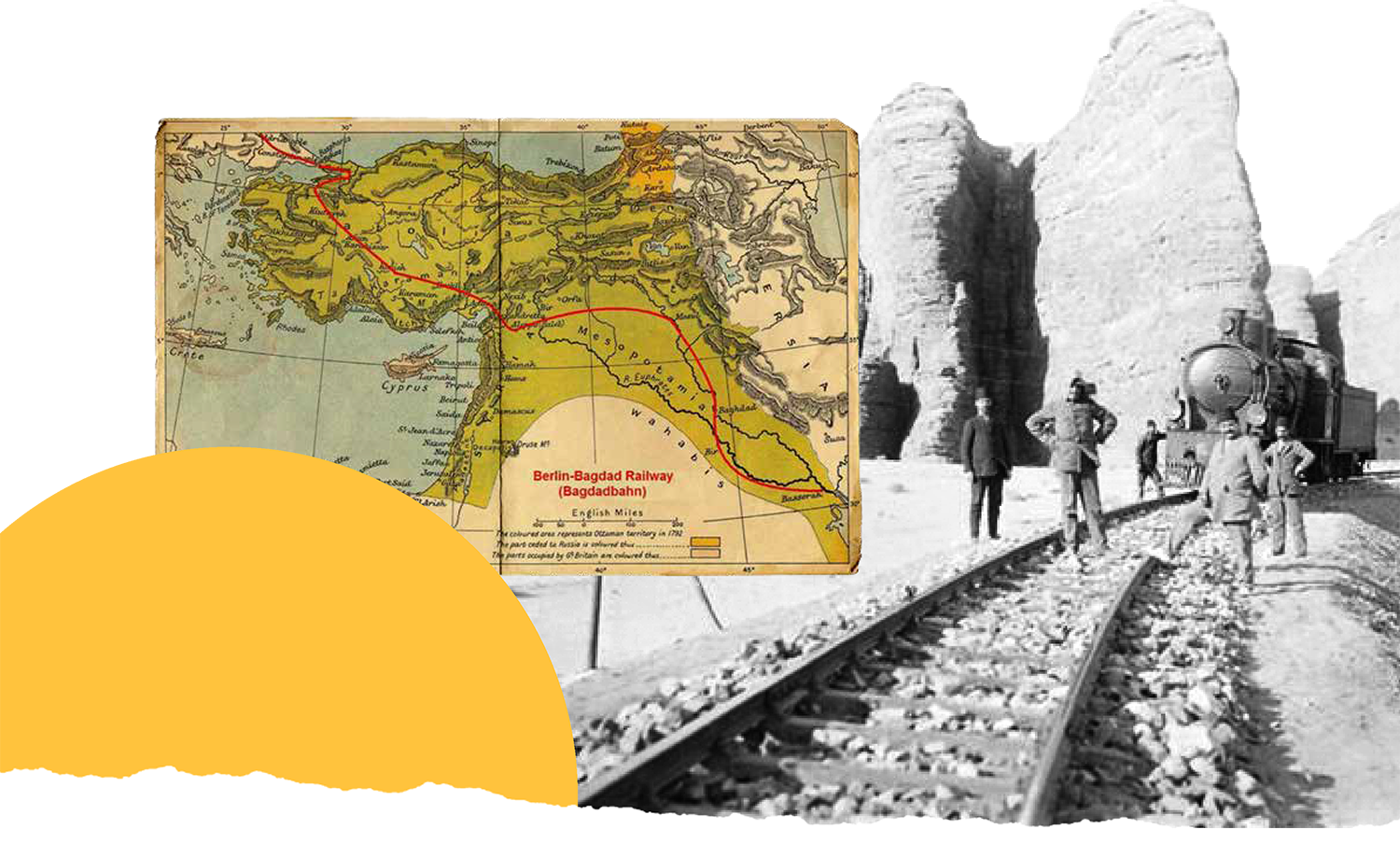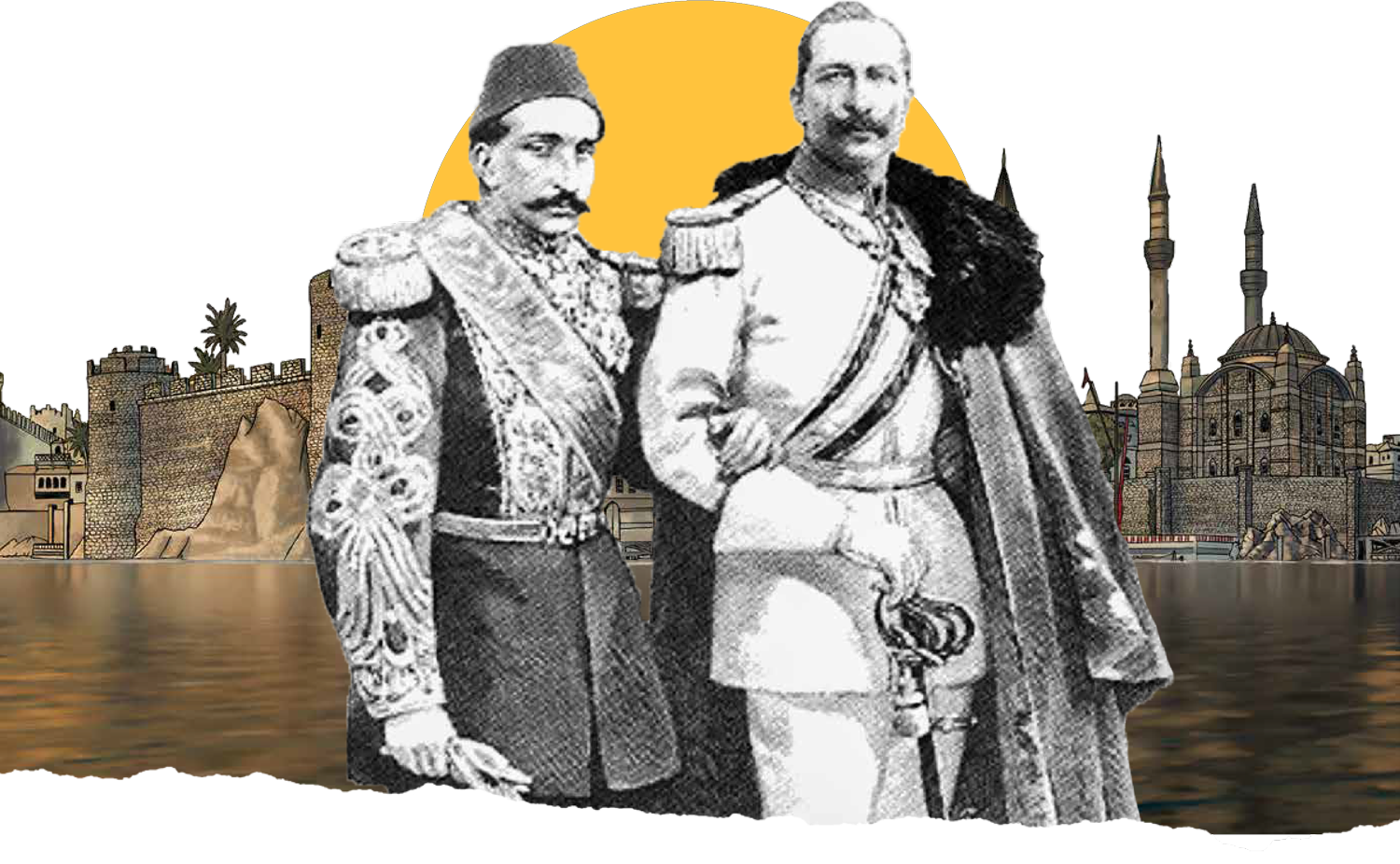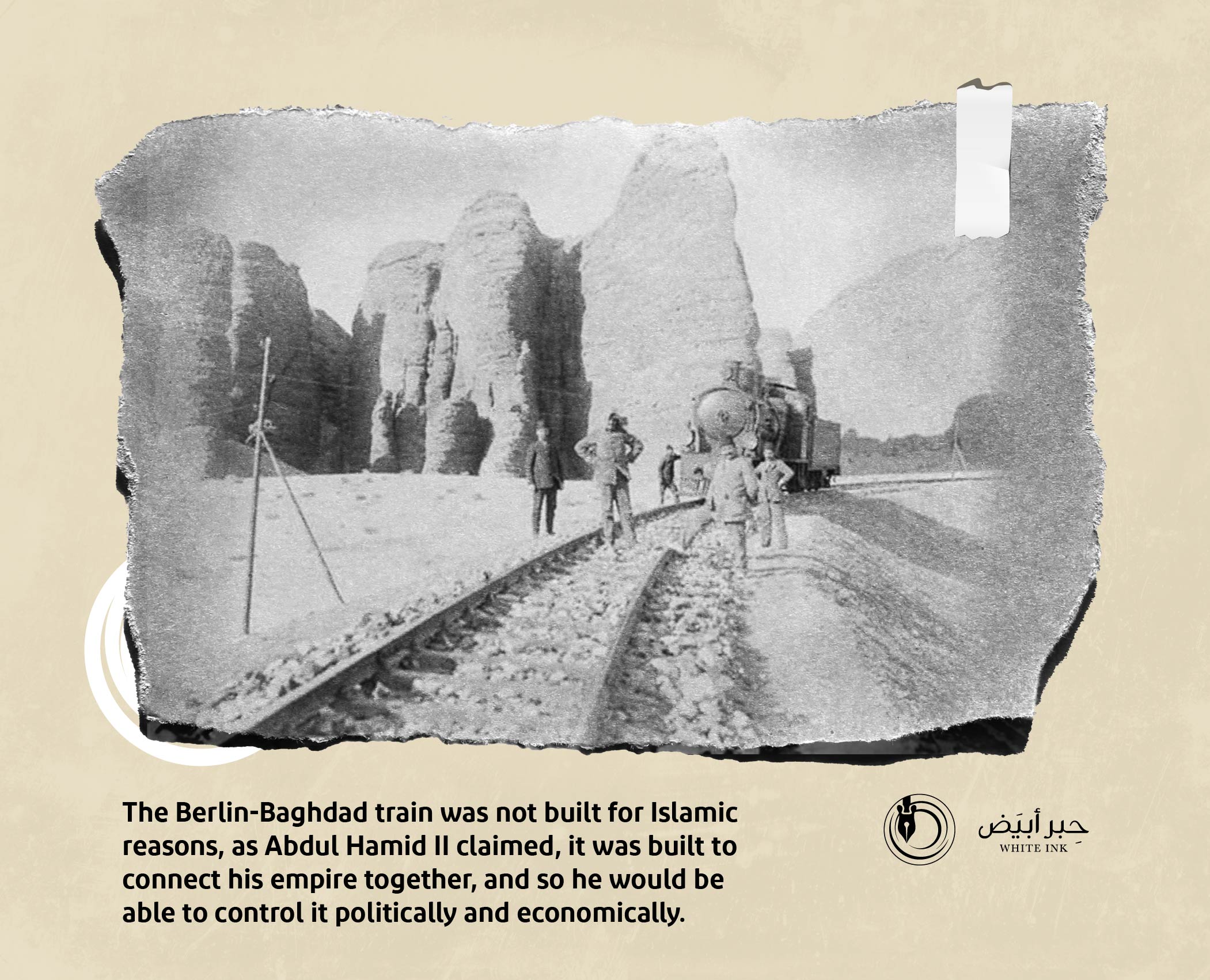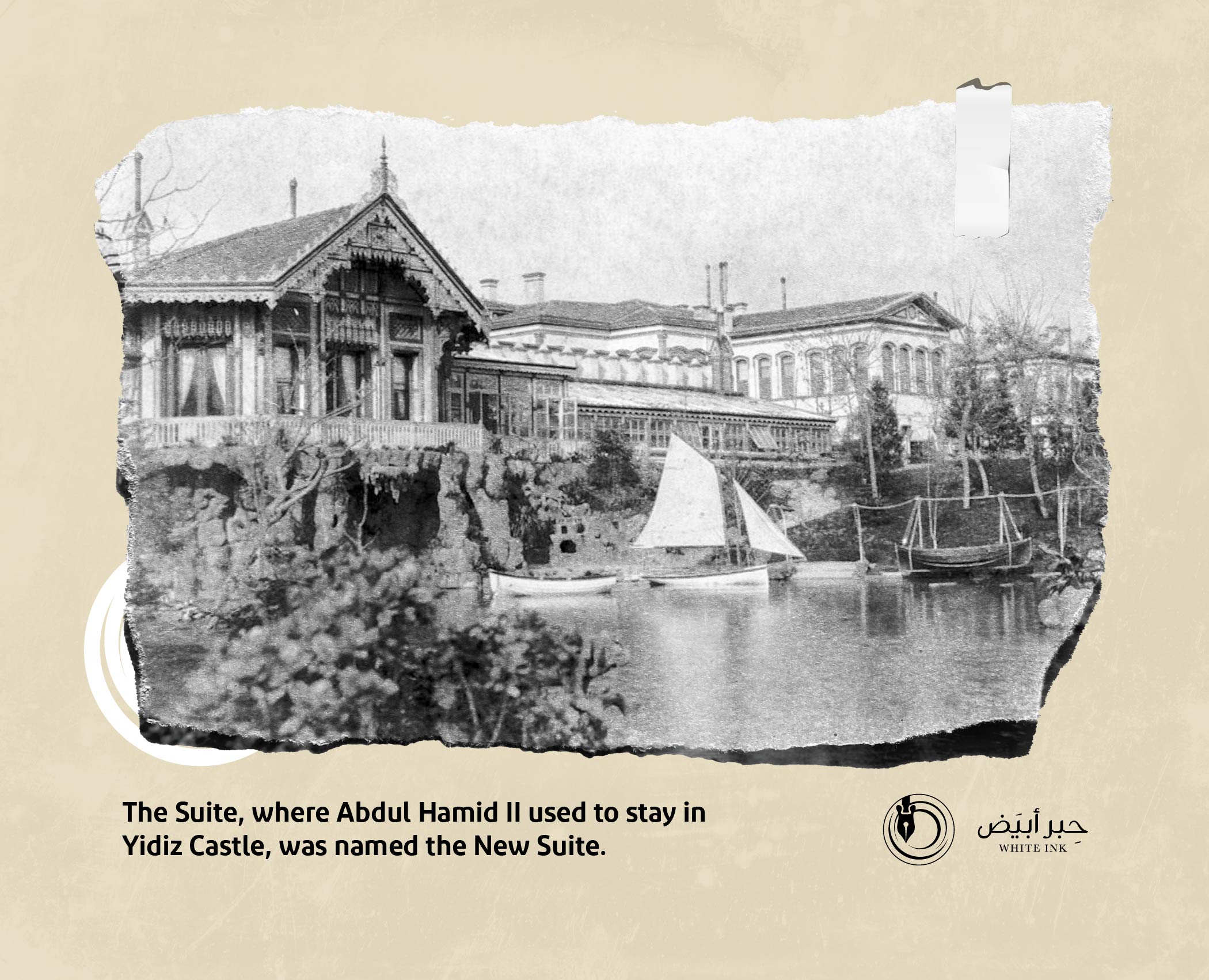
He was the Jews' Bridge to Palestine
The Snake Abdul Hamid...
The railway of (Berlin - Baghdad)
It was part of the project to tighten control over the Arab countries.

The railway was established for the purpose of linking the territories of the Ottoman Empire and tightening control over them, especially in the Two Holy Mosques, in which the Ottomans had noticed there existed severe restlessness. Another branch line was established on it that extended to Haifa on the Mediterranean coast, which contributed to supporting Abdel Hamid’s project with the Zionist Theodore Herzl, founder of the Zionist movement, to Judaize Palestine, when the train was used to bring tens of thousands of Turkish Jews to Palestine.
The Hejaz Railway was part of a political and social network that acted to tighten Turkish control over the Arabs and impose Turkification on them. This was later evident in the crime of “Seferberlik,” according to which Fakhri Pasha – the governor of Medina – forcibly deported the residents of Medina in 1914 CE and transported them to Turkey, Albania, and Bulgaria. Turkish, Albanian, and Bulgarian soldiers were brought by the Ottoman railways to Medina as a substitute for its inhabitants.
The "Haifa" station contributed to bringing the Jews of Turkey to Palestine.

The purpose that Abdul Hamid promoted often was to link Istanbul with the Two Holy Mosques, to transport the Ottoman pilgrims, as Abdul Hamid was at that time waging a bitter struggle inside the palace and within the ruling class that turned against him more than once. The railroad was an attempt to tickle the Turkish nationalist sentiments in order to gain the approval of the inner street, and the first of September, the anniversary of the Sultan’s accession to the throne, was deliberately chosen as the date for the start of construction work on the line with the aim of consolidating the position of the Sultan. Abdul Hamid II mentioned in his memoirs of the Hejaz Railway the following: “Finally, the Hejaz line has come to fruition—this dream that has always struck my imagination. It will enhance our military capacity throughout.”
Here is the Sultan himself dropping all the cheap propaganda promulgated by the new Ottomans about the economic and military goal of the railway, which was also employed for another, no less ugly goal, which is the forcible Turkification and deportation of the indigenous people in the Arab countries, especially in Medina, the Levant and Iraq. It is also important to draw attention to the fact that, after its completion, the Hejaz Railway did not have any debts due to the large turnout of the common Muslims and their wealth that was donated without costing the Ottoman Treasury a single Ottoman Lira.
It was brought to the attention of many scholars how they played with religious feelings on the Hejaz Railway, for purposes beyond that, as reported by the researcher at King Abdul Aziz University, Azza bint Awad bin Halis Al-Juhani, who said: “The importance of the religious factor has been shown in the completion of a railway project. Hejaz, although it does not represent the real motive for it, and the political obstacles are the most important obstacles that accompanied the implementation of the project, in addition to the political, economic and social impacts of the Hejaz Railway’s arrival to Medina.”

After the Humiliating Defeat Against Russia and the Independence of the European States
He Exploited the Pilgrims to the House of Allah for Rejuvenating the Spirit of the "Sick Man"
The project of completing the Hejaz railway was a significant event for the Ottoman State and the rest of the territories that it occupied. Even the project was described by some people as a new Islamic conquest. This was in light of the Ottoman “propaganda”, which promoted this project, and considered it as a response to the urgent necessity of Muslim pilgrims, who suffered during the pilgrimage season from complicated problems owing to the great distance and the length of journey. In addition to the troubles that were caused by some bandits, who were targeting the convoys of pilgrims that were heading towards Hejaz.
Historically, the interest of Ottoman State in establishing the Hejaz Railway began in the early second half of the 19th century. When the American engineer, Zimpel, in (1864 AD) provided the first sketch of the project that was related to the establishment of the railway to be extended from Istanbul to Medina. Nevertheless, the high cost of the project led the Sultanate to reverse its implementation on the ground.
With assumption of Sultan Abdul Hamid II, the reigns of government in (1876 AD). He tried to restore the spirit to the Ottoman State, which practically began its stage of collapse after the repeated defeats on the Western Front. Perhaps the most important one of which was the immense defeat, which it suffered by the Tsarist Russia that allied with the Balkans countries. Sequentially, these latter demanded independence from the Ottoman State. As they were sapped of taxes that were imposed by the Ottoman family to cope with the effects of the drought in the Anatolian region, the heart of the Ottoman Sultanate, that caused the famine of (1873-1874 AD).
Facing these repeated strikes and setbacks in Eastern Europe and rising nationalist demands for independence from the Ottomans, Abdul Hamid II attempted to focus on and preserve the Islamic side of the Ottoman State through re-mobilizing the institution of the Islamic Caliphate. This situation forced him to think about the need for continuing subjugation of the Hejaz and Jerusalem under his power. Knowing that the Holy Places remain holding a great religious symbol and presenting the center of gravity for the Islamic world. Further, any success for the independence demands in these regions would practically lead to losing the dreams of the Ottoman Empire and losing that religious impetus provided to it by a region that has a religious nature such as the Two Holy Mosques.
Reviving the Hejaz Railway Project to prevent the collapse of the “Sick Man” empire.

He promoted the railway project as if it was arising from his religious duties towards Muslims.

In the same direction, the British historian Charles Swallow believed, who is the author of “The Sick Man of Europe” book: From the Ottoman Empire to the Turkish one (1857-1923 AD) “, where he said: “The Hejaz Railway Project, which connects Levant, Medina and Makkah to each other, became one of the most important projects that the Sultan bore the burden of its implementation upon his shoulders after his completion of the Baghdad Railway Project. Since this project played a vital role in realizing the plans of Abdul Hamid and implementing the aims of Islamic unity policy that he was about to carry out”.
Additionally, it seems that the idea of completing the project was originally a merely political idea that had nothing to do with the interest of Ottoman family in helping the pilgrims to the House of Allah. This fact was confirmed by the calls of the Ottoman governor in the Hejaz, Ottoman Nuri Pasha, who called for renewing and reviving the idea of this project, in the year (1892 AD), for military reasons. However, what remains well-established that Sultan Abdul Hamid II exploited the feelings of Muslims to promote them to finance a project whose real aim was far from religious motivations. This was what he achieved, as the writings were unanimous in concluding that the funding was mostly from the Muslims. Here we find that Matin Hulagu says: “There is no doubt that the Hejaz Railway was one of the most important religious and political initiatives during the era of Sultan Abdul Hamid II. It was entirely built with the funds of Muslims and their material and moral donations”.
As for the strategic side, the Turkish colonialism suffered from the concentration problems of security and military build-up. As there were, at the outskirts of the Sultanate, increasing independence trends. This prompted the Ottoman State to adopt a war strategy that would help it to intervene in the various regions under its sultanate. As that was in accordance with the strategic approach that was known as “Maneuvering on the Internal lines”, which is a kind of strategy that the Swiss theorist, Antoine Henri de Jominy, was famous for. This strategy guarantees the freedom of maneuver and movement on internal lines and avoiding the concentration and establishing armies in separate regions. Therefore, the state would not be exhausted by many expenditures on the salaries of soldiers, equipment and supplies. This also assures the ease of moving them by train to the regions that were under the Ottoman State. As train was the preferred means of transporting soldiers at that time.
The coercion that was decisive, as we believe, to launch the Hejaz Railway Project. It was to achieve the strategic goal of rapid access to the Arab regions that were under the Ottoman occupation. Particularly that there was a group of major powers, which were looking for a foothold in the Arab region, as a result of the successive discoveries of oil. Where they exploited the Arab feelings of hostility against the Ottoman colonial project. As they tended to build alliances that contributed to the acceleration of the overthrow of Ottoman dominance as well as the emergence of some countries on the new map of the region.

Even in "Pragmatism", He Was Unsuccessful
The Germans Replaced Abdul Hamid's "Idiotic" With the Ambitions of Federalists
Abdul Hamid II distributed the concessions of his state to appease the European countries.

Here we can understand the reason for the tendencies of Abdul Hamid II to ally himself with Germany for merely pragmatic political reasons, despite his leadership of the Islamic League and his hostility to the West, as this is the politics that does not be influenced by religion.
Abdul Hamid II justified his policy of leaning towards and allying with Germany by many factors that have led to that. In his view, there were no adjacent borders between the Ottoman State and Germany, so there were no border disputes. While at the same time he did not deny his deep admiration for the German military system and its ability to support and train the Ottoman Army. In addition to that, the great modernization of the German industries, and the possibility that the Ottoman State could benefit from this condition.
As for Germany, the alliance with the Ottoman State was exclusively pragmatic as well. Perhaps the best indicator in that regard is the report that was written by the German Ambassador in Istanbul, Halter Field, in the beginnings of the year (1880 AD); when he said: “The French influence in Istanbul was ceased by the end of Napoleon I. That influence, which began in the era of Suleiman the Magnificent. Yet, if the French influence was replaced by the English influence during the era of the crafty English Prime Minister, Lord Palmerston. This ended in turn during the time of Lord Gladstone”. He thus pointed out the necessity for Germany to fill that gap. As he requested from the German Kaiser to accelerate towards that purpose.
William II intimated to the Sultan with the delusion of "the Caliphate".

The concerns of European countries increased when Abdul Hamid II granted Germany the concession of the Baghdad railroad line. As this line meant that the influence of Germany was extended in Asia, which was posing a threat to the influence of European, particularly the English influence, in the region.
Abdul Hamid II realized how angry England and France were at the growing influence of Germany on the Ottoman army and economy. So, he attempted to appease them; as Britain was granted the concession of implementing the Western Anatolia railroad line, as well as the concession of repairing the Ottoman Navy. While France was granted the concession of a railroad line in Syria, and also the reorganization of the Ottoman police conditions.
Furthermore, The Turkish historian, “Suleiman Jouka Bash”, asserts that Abdul Hamid II resorted to an alliance with Germany in order to establish a balance between the big European countries that set themselves up as an enemy of him. According to the belief of that the enemy of an enemy is a friend. However, he describes his relationship with Germany as being a “haven of a persistent danger”. As on the one hand, it provoked the great European countries, particularly England, France and Russia. Because of their dissatisfaction with the growing influence of Germany within the Ottoman State. On the other hand, the members of the Union and Progress took advantage of this policy in eliminating the Sultan himself.
Hence, Germany had to request the consideration of its support for the Ottoman state. As that is which was stated by the German Kaiser during his meeting with the Sultan. That if Germany waged a war in Europe against England and France, the Ottoman State should stand with Germany and engage in that war backing it. But Abdul Hamid II wanted to manipulate Germany, and he didn’t realize the “cost” of this conduct. Moreover, he tried to evade these commitments. Accordingly, “the members of Young Turks Association became the favoured ones of the Germans. Sequentially, the Germans began to use the association members’ arrivals and departures from Germany against Turkey and the Sultan”. So, Suleiman Jouka Bash demonstrates the transformations in the relationship between Abdul Hamid II and Germany.
The end of that story was described by the daughter of Abdul Hamid II, by saying that: “My father was unable to confront the Union and Progress Association, which was completely surrendering and obedient to the German propaganda”.
However, the policy of Abdul Hamid II, “the enemy of an enemy is a friend”, did not work out in winning the Germans, nor did it succeed in taming the German ambitions in the Ottoman State. In the end, the monster turned against its creators, and he was dismissed.
The Encyclopaedia of the Ottoman State describes the end of the era of Abdul Hamid II: “After more than 30 years of his accession to the throne, the Empire was, in terms of structure, in a condition that beyond repair”.






